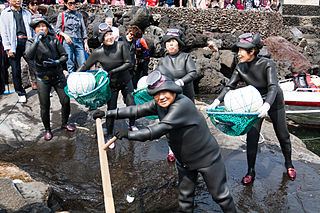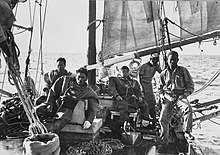
A pearl is a hard, glistening object produced within the soft tissue of a living shelled mollusk or another animal, such as fossil conulariids. Just like the shell of a mollusk, a pearl is composed of calcium carbonate in minute crystalline form, which has deposited in concentric layers. The ideal pearl is perfectly round and smooth, but many other shapes, known as baroque pearls, can occur. The finest quality of natural pearls have been highly valued as gemstones and objects of beauty for many centuries. Because of this, pearl has become a metaphor for something rare, fine, admirable and valuable.

Dhow is the generic name of a number of traditional sailing vessels with one or more masts with settee or sometimes lateen sails, used in the Red Sea and Indian Ocean region. Typically sporting long thin hulls, dhows are trading vessels primarily used to carry heavy items, such as fruit, fresh water, or other heavy merchandise, along the coasts of Eastern Arabia, East Africa, Yemen and coastal South Asia. Larger dhows have crews of approximately thirty, smaller ones typically around twelve.

Freediving, free-diving, free diving, breath-hold diving, or skin diving, is a mode of underwater diving that relies on breath-holding until resurfacing rather than the use of breathing apparatus such as scuba gear.
The music of Bahrain is part of the Persian Gulf folk traditions. Alongside Kuwait, it is known for sawt music, a bluesy genre influenced by African, Indian and Persian music. Sultan Hamid, Ali Bahar and Khaled El Sheikh are among the most popular musicians from Bahrain.

Diving activities are the things people do while diving underwater. People may dive for various reasons, both personal and professional. While a newly qualified recreational diver may dive purely for the experience of diving, most divers have some additional reason for being underwater. Recreational diving is purely for enjoyment and has several specialisations and technical disciplines to provide more scope for varied activities for which specialist training can be offered, such as cave diving, wreck diving, ice diving and deep diving. Several underwater sports are available for exercise and competition.

Ama are Japanese divers famous for collecting pearls, though traditionally their main catch is seafood. The vast majority of ama are women.

Haenyeo are female divers in the South Korean province of Jeju, whose livelihood consists of harvesting a variety of mollusks, seaweed, and other sea life from the ocean. Known for their independent spirit and determination, haenyeo are representative of the semi-matriarchal family structure of Jeju.

Fidjeri is the specific repertoire of vocal music sung by the pearl divers of Eastern Arabia's coastal Gulf states, especially Bahrain and Kuwait. A lead singer is backed up by a chorus of accompanying singers and clapping. The accompanying instruments to a fidjeri ensemble are a small double-sided hand-drum, known as the mirwās and the jāhlah, a clay pot played with both hands.
Nakhuda is derived from the Middle Persian nāw khudāy "master of the boat".

Pearling in Western Australia includes the harvesting and farming of both pearls and pearl shells along the north-western coast of Western Australia.

Cubagua Island or Isla de Cubagua is the smallest and least populated of the three islands constituting the Venezuelan state of Nueva Esparta, after Margarita Island and Coche Island. It is located 16 kilometres (10 mi) north of the Araya Peninsula, the closest mainland area.

The History of Bahrain (1783–1971) covers the history of Bahrain since the invasion of Al Khalifa until the independence from the British Empire.

Pteria sterna, or commonly known as the rainbow-lipped pearl oyster or the Pacific wing-oyster, is a species of marine bivalve mollusk in the family Pteriidae, the pearl oysters. This oyster can be found in shallow water along the tropical and subtropical Pacific coast of America, its range including Baja California, Mexico and northern Peru.

Pinctada mazatlanica is a species of tropical marine bivalve mollusc in the family Pteriidae, the pearl oysters. It is known by the English common names pearl oyster, Mazatlan pearl oyster, and Panama pearl oyster. Spanish common names include madre perla, and ostra perlifera panameña. This mollusc was first described to science in 1856 by conchologist Sylvannus Charles Thorp Hanley. Pinctada mazatlanica produces gem-quality pearls and was the basis of a pearling industry in the Gulf of California for centuries.
Brian Andrew Hills, born 19 March 1934 in Cardiff, Wales, died 13 January 2006 in Brisbane, Queensland, was a physiologist who worked on decompression theory.

The history of underwater diving starts with freediving as a widespread means of hunting and gathering, both for food and other valuable resources such as pearls and coral. By classical Greek and Roman times commercial applications such as sponge diving and marine salvage were established. Military diving also has a long history, going back at least as far as the Peloponnesian War, with recreational and sporting applications being a recent development. Technological development in ambient pressure diving started with stone weights (skandalopetra) for fast descent. In the 16th and 17th centuries diving bells became functionally useful when a renewable supply of air could be provided to the diver at depth, and progressed to surface-supplied diving helmets—in effect miniature diving bells covering the diver's head and supplied with compressed air by manually operated pumps—which were improved by attaching a waterproof suit to the helmet and in the early 19th century became the standard diving dress.

For most of its history, Qatar practiced slavery until its abolition in 1952. Many members of the Afro-Arabian minority are descendants of the former slaves. Chattel slavery was succeeded by the Kafala system. The kafala system has been abolished in Qatar since December 2016.

Slavery existed in the Trucial States (1892–1971), which later formed the United Arab Emirates. The Trucial States consisted of the Sheikdoms Dubai, Abu Dhabi, Sharjah, Ajman, Umm Al Quwain, Fujairah, and Ras Al Khaimah. The region was mainly supplied with enslaved people from the Indian Ocean slave trade, but humans were also trafficked to the area from Hejaz, Oman and Persia. Slaves were used in the famous pearl fish industry and later in the oil industry, as well as sex slaves and domestic servants. Many members of the Afro-Arabian minority are descendants of the former slaves.

Open slavery existed in Kuwait until the 1940s. Slavery was formally abolished in Kuwait in 1949. In practice, slavery was not actually abolished as such, but the law no longer recognized it after 1949, which meant that every slave who applied for manumission was guaranteered to be freed. Many members of the Afro-Arabian minority are descendants of the former slaves. Slavery of people from Africa and East Asia was succeeded by the modern Kafala system of poor workers from the same region were slaves had previously been imported.

Open slavery existed in Bahrain until the 1930s. Slavery was formally abolished in Bahrain in 1937. Slavery ended earlier in Bahrain than in any other Gulf state, with the exception of Iran and Iraq. Many members of the Afro-Arabian minority are descendants of the former slaves. Slavery of people from Africa and East Asia was succeeded by the modern Kafala system of poor workers from the same region were slaves had previously been imported.
























